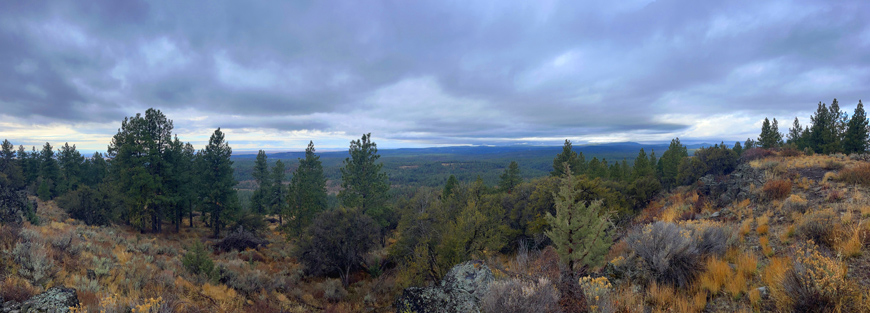Top photo: Malheur National Forest
Recently, I made a much-anticipated return to Malheur National Forest to hunt for elk. Maybe I was forecasting my own fate, but I prefaced my excitement internally and externally with the statement, “I don’t even care if I harvest an elk, I just really enjoy walking through the woods this time of year!” Well, the forest views and experiences did not disappoint, and neither did the fact that I didn’t get to bring home any elk meat either.
Not until you actually get away from your busy life can you understand the value of unplugging from the bustle and bothers of your everyday goings on. I didn’t know what was going on in the Middle East, I didn’t have emails to answer or phone calls to return, and thankfully, the wife took good care of the kid, whose Halloween birthday cost me the opening day of my limited 5-day hunt. Still, a small price to pay for my greatest joy, who won’t be celebrating that many more birthdays at home with the parents.
Hunting with a couple of friends that you may only see once or twice every two years, experienced outdoorsmen who know every road, every rim-rock hill top and every mahogany patch where elk can live, is an advantage few others have access to. Couple that with the possibility of seeing one of North America’s greatest land mammals, when in reality most every other American never does, and that is something I wish everybody could take advantage of.
The landscape tells a story, if you pay attention. Besides seeing a large number of fresh tracks, gobs of fresh scat, antler sheds and turkey feathers, I recognized the incredible opportunity to traverse public lands that belonged to everyone, and not conquered by anyone. I learned what the “Green Sheen” was – elk poop so fresh it wasn’t even brown yet. And realized maybe the greatest reality check that this city kid needs to keep in mind, that if it wasn’t for my hunting app, I’d a been coyote food a long time ago. I feel more confident in a thick bank of fog in the middle of the Pacific than I do side-hilling the ridgetop at Demeris Springs. My map app looks like a drunken sailor walking through the woods. I’m sure the elk got a good laugh at that.
One experienced hunter told me of a hunt he had done earlier in the morning, where he walked past a juniper tree, and about 30 feet away, turned around and just happened to look at the base of that same tree, surprisingly identifying what looked like two nostrils staring him in the face. Sure as heck, a spike bull stood up after about 40 seconds, and walked off into the deeper woods. How many times has that happened to me?
After countless miles of side-hilling, scaling the rim-rock and sliding downhill to reach the final destination to prepare for the next hunt, it feels ok being back on flat ground. I’ll head back to the saltwater in search of sport-caught crab, maybe some bottomfish if the seas cooperate, and strategize about next year’s opportunities, if they indeed come about.
My long walks through the woods made me grateful that fish don’t have a brain the size of the cervids (elk) I sought all week, they don’t flee when I’m within 40 yards of them, and they are much easier to find successfully when pursuing. That is certainly why a more intensive management strategy is needed to keep them available to future generations of anglers.
Planning is already underway for bottomfish, halibut and salmon seasons for 2024. Not many anglers are taking note of what the options are and how best to take advantage of what’s available. Most of my friends and I eagerly await the run forecast due out next month, which will give us a picture of how the 2023 season performed and what to expect in 2024 for our salmon and steelhead runs. We’re always optimistic, and often disappointed.
Most fishing businesses are winding down for the year, and Congress is as well, especially if lawmakers play chicken again with the debt ceiling. But as we all know how quickly time goes by, agendas are churning, strategies are being laid, and fishermen have the next season on their minds.
We still have the big “To Do,” in the reauthorization of the Magnuson-Stevens Act (MSA), the keystone law that governs our vast public saltwater around the country. There are smaller components of that law, however, that stakeholders may find greater commonality in, that will make it easier to navigate the complex Congress we now have. I’ve been asked to go back to Washington, DC in December to address a key component of MSA on sustainable recreational fisheries and data modernization. With a sudden hic-cup in black rockfish stocks, anglers and the agency will be looking for ways to prosecute fisheries in a sustainable manner, without compromising sensitive coastal economies reliant on this resource. It’s certainly a delicate balance.
With my tuna finally canned, and vacuum-packed salmon ready for holiday smoking, there’s crab to catch, to make sure all my friends and family get to share in the bounty. As far as the hunting goes, there are two key phrases I had to revisit this elk season, phrases I usually break out when a customer loses a fish close to the boat. They certainly have application when it comes to my hunting skills:
“You can’t barbeque a memory,” and “Thank God for grocery stores.”
Let’s hope for a more productive season on Capitol Hill.
And if you didn’t catch our springtime Waterside Chat, here’s a fun watch if you have nothing else better to do for 55 minutes of your life.


